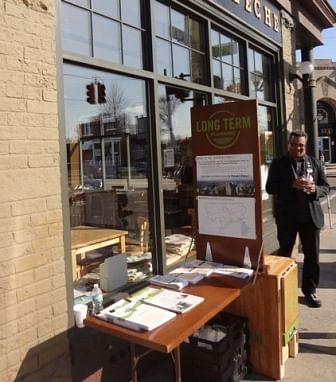

The following are project narratives from the second day of the Public Interest Design Institute in Cincinnati. Take the SEED Pledge today!

Design Thinking
Ramsey Ford, Design Director and Co-founder of Design Impact
Ford discussed an ongoing project for improving the Sarai cooking system, which aims to reduce carbon emissions and create safe cooking environments. The current Sarai cook stove reduces particulate matter and carbon monoxide in indoor environments compared to traditional cook stoves, but the product’s reach hasn’t been wide. Engaging with technical experts from partner ARTI and users of the stoves, a Design Impact fellow is working on a redesign that will work better, sell more, and have a greater impact.
Ford described the design process of Design Impact, which begins with establishing goals and self reflection, and stressed the importance of integrating user insight, technical knowledge, and visual communication in the design process. Showing a table made for the Sarai project, Ford described the process of establishing outcomes, goals, activities, and indicators. Given the goal of reducing negative health effects of wood burning stoves, Ford had small groups of attendees create their own roadmap using this process.
Takeaways:
More Information:

Detroit Works Project
Dan Pitera, Director of Design for Detroit Collaborative Design Center, University of Detroit Mercy School of Architecture
The Detroit Collaborative Design Center develops neighborhood spaces, neighborhood strategies, and neighborhood catalysts. In addition to discussing past projects, Pitera focused his lecture on the Detroit Works Project, an ongoing project that has already engaged 163,000 residents of to talk about their community and land use. Through discussion of this and other projects, Pitera outlined several successful strategies to engage citizens, including:
Of the 163,000 residents reached by the project, 30,700 have been meaningful interactions, defined by Pitera as opportunities to exchange ideas rather than simply inform or receive feedback.
Takeaways:
More Information:

Manufactured Migrant Housing
Bryan Bell, Founder of Design Corps, Co-founder of SEED
Bell became interested in migrant housing after his sister sent him pictures of housing conditions she documented as part of her work with Legal Services. Leaving the traditional architecture office environment, Bell received an AIA grant to study housing for farmworkers. He subsequently accepted a housing developer position with Rural Opportunities in Pennsylvania under the terms that he could practice design outside his 40-hour weeks and, after two years, if they saw value in design, Bell could change the job description accordingly.
In his study of migrant housing, Bell discovered problems of accountability in the traditional bullpen and crew leader model and problems of disparate values between migrant subgroups of single men and families. He addressed these issues in the design of manufactured housing, which proved to be socially and economically feasible. Bell engaged in discussions with farmers to better address their needs; for example, Bell included porches with sinks and storage to reduce insecticides brought into the houses and limited house sizes to five men to increase accountability and promote durability.
Takeaways:
More Information:
This blog will provide a recap of events - lectures, gallery openings, major reviews, etc. - at the University of Cincinnati's School of Architecture and Interior Design. Most entries are written by graduate assistants at SAID; other authors will be noted by post.



No Comments
Block this user
Are you sure you want to block this user and hide all related comments throughout the site?
Archinect
This is your first comment on Archinect. Your comment will be visible once approved.